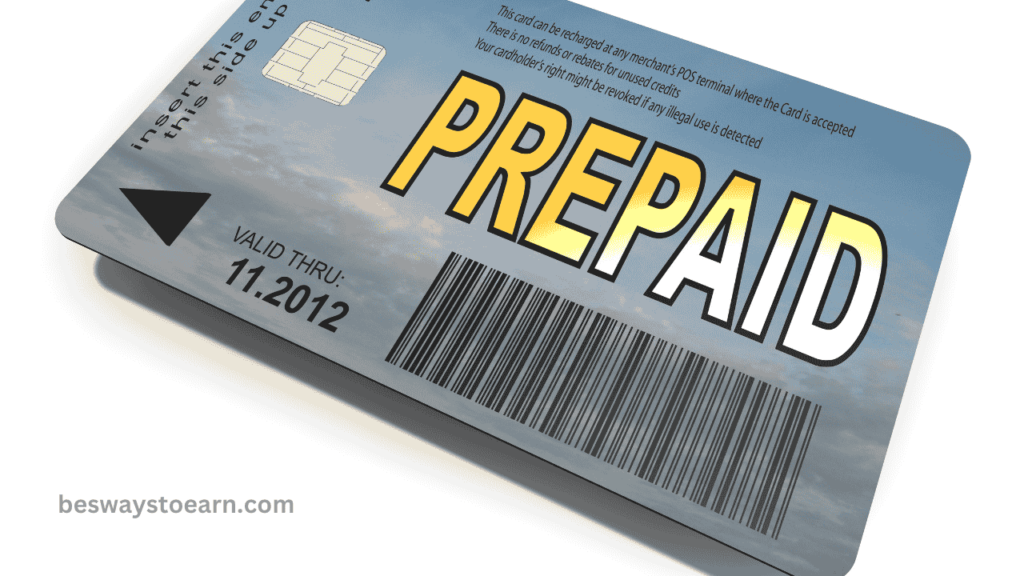Table of Contents
How Do Companies Earn Money from Prepaid Cards? 7 Key Ways They Profit Explained
Introduction: The Growing approval of Prepaid Cards
In recent years, prepaid cards have become crucial to modern business ecosystems. These cards allow users to load money onto them like a debit or credit card. Prepaid cards add flexibility and accessibility to travel, online shopping, and budgeting. However, while prepaid cards benefit applications, many people wonder how companies earn money from them. This article will investigate how companies earn money by using prepaid cards.
Prepaid cards are not just an acceptable tool for consumers; they also perform a sweet revenue stream for the companies that problem them. From intercourse fees to partnerships with retailers, companies achieve significant income through different strategies. This comprehensive guide will analyze how these companies benefit from prepaid cards and the commercial mechanisms at play.

1. Transaction Fees: A Key Income Source
One of the cardinal ways that companies earn money from prepaid cards is through agreement fees. Every time a user wipes their prepaid card, the issuing company earns a small percentage or a planar fee. These fees can come from specific sources, involving:
- Point of Sale (POS) Transactions: The company may charge the operator a transaction fee when clients use their prepaid card for in-store purchases. The cost is typically a small percentage of the deal amount, but it adds up over time when millions of cards are in transmission.
- Online Transactions: Like in physical stores, companies earn money when prepaid cards are used for online investments. This includes payments on e-commerce sites, subscription services, or international agreements. The fee for processing these agreements can vary based on the card’s issuer and the platform invcard’s
- ATM Withdrawals: If the cardholder uses the prepaid card to withdraw cash from an ATM, the company typically incurs a withdrawal fee. This fee can vary depending on whether the ATM is attached to the same network as the card issuer or a third-party ATM.
While these may seem small on a particular basis, they can generate significant income for companies when applied to many cardholders and agreements. Agreement fees can be a prepaid card issuer’s most profitable income stream.
2. Activation Fees: Charging Customers to Get Started
Many prepaid card issuers complain about an initial activation fee to applicants when they first acquire or register the card. This fee is typically non-refundable and is a one-time charge prepared at activation time. The activation fee can range from $5 to $15 or more, depending on the type of card and the issuing company.
Although this fee is a one-time charge, it boosts the company’s income by earning money for the company; therefore, the cardholder even activates it. For some companies, activation fees are a cardinal part of their overall business model, especially when paired with other forms of recurring income.
3. IMonthly Maintenance Fees: Ongoing incomes
Many prepaid card issuers charge a monthly maintenance fee to keep the card at work. These fees can limited from a few dollars to $10 or more each month. While some cards have no monthly fee, others have this charge in exchange for added properties like free ATM withdrawals or an approach to absolute rewards.
These fees are typically abstracted automatically from the cardholder’s balance, ensuring the cardholder receives approved income from users who keep the card at work. Monthly maintenance fees are one of the surest sources of income for prepaid card companies, and they can start adding up if the cardholder does not pay attention to their card balance.
For instance, a company charging a $5 monthly fee for 1 million cardholders can achieve $5 million in annual income from this individual.
4. Foreign transaction Fees: Earning from Global purchases
Prepaid card companies also earn foreign transaction fees when clients use their cards to create properties in foreign currencies. These fees are typically limited from 1% to 3% of the transaction expense and are charged to cover the currency conversion amounts.
As global travel and cross-border e-commerce increase, prepaid card companies can capitalize on this trend by charging foreign transaction fees. This is particularly beneficial for companies that issue cards for international use, as these fees are charged on a maximum of any other applicable transaction amounts.
5. Partnerships and Co-Branding Deals: Earning through connections
Companies can also earn money from prepaid cards through partnerships with retailers, commercial institutions, and other organizations. Co-branding arrangements allow companies to work with big brands to issue prepaid cards with logos and branding from the prepaid card issuer and the partnering association.
These partnerships can lead to multiple income opportunities:
- Sign-up Bonuses: In some cases, prepaid card issuers offer sign-up bonuses or discounts to applicants with co-branded cards. These bonuses can help increase sales, which benefits both the issuer and the assistant.
- Retailer determinant: Companies may assist retailers in adding special commissions or incentives to clients who use their prepaid cards at limited locations. This not only engages new users but also furthers brand loyalty.
- Income Share: Companies involved in co-branding deals often negotiate income-sharing agreements with partners. Both parties earn a share of the car card’s transaction and activation fees in these agreements.
6. Prepaid Card Provide Fees: Earnings from Card Recharges
Prepaid cards can be used with funds through absolute security, bank transfers, or physical supply deposits at retail positions. Companies regularly charge reload fees for this service, particularly when users reload their cards in customer.
While provide fees are generally small (typically ranging from $1 to $5), they can add up if cardholders offer frequently. These fees help companies maintain the profitability of their prepaid card actions while providing an agreeable service for users.
Some companies may also charge additional fees for online reloads or use third-party networks, earning a portion of the reload fees paid by the cardholder.
7. Unclaimed Funds: Passive Revenue from Dormant Accounts
Companies may also benefit from unclaimed or abeyant prepaid card accounts. If a cardholder fails to use their card for an extended period, the community may be allowed to direct the remaining balance after a secure amount of time has passed.
This process, known as “es” treatment,” a”lows the issuer to” r” quire the”fu “ds as income. The rules regarding unclaimed funds vary by jurisdiction, but in some cases, companies can adequately retain the balance after an established period of deferral (usually several years).
Although this income stream may not be as predictable or steady as transaction fees, unclaimed funds can be an expressive source of passive income for companies actioning prepaid cards.
Conclusion: Why Prepaid Cards Are a Win-Win for Both Companies and Clients
Prepaid cards have been analyzed as profitable products for many commercial institutions, retail companies, and the payments industry. Companies earn income from transaction fees and activation imputations to partnerships and provide fees in various ways. These commercial products provide customers with an agreeable way to command their money while allowing companies to tap into multiple income streams.
Whether you’re a customer considering the benefits of prepaid cards or a business looking to understand how prepaid cards can help your bottom line, it’s clear that they have become critical tools for both sides. Companies not only earn substantial income from these cards but also act as valuable commercial products that meet the requirements of modern customers.
In conclusion, companies earn money from prepaid cards through transaction fees, activation charges, monthly maintenance fees, and partnerships with retailers. As the market for prepaid cards continues to rise, I predict these companies will continue establishing and finding new ways to obtain these highly profitable creations. How Do Companies Earn Money from Prepaid Cards? 7 Key Ways They Profit Explained
FAQ
How do prepaid card companies create money?
Net Expend earns money through a collection of fees, such as the monthly plan fee, transaction fees, ATM withdrawal fees, replacement card fees, and inactivity fees. It is one of the key players in the prepaid card industry; its competitors are JPMorgan Chase, Juice Financial, and American Express.
How do companies create money off of gift cards?
Some wonder whether retailers and businesses also benefit from gift cards. The answer is yes. Businesses make money when people impulse buy their gift cards. They also profit from unused or depleted gift cards and when people spend more than the amount on the card.
Where does the money come from on a prepaid card?
A prepaid card is not linked to a bank or credit agreement account. Instead, you put money into the card account, sometimes called loading money onto the card, before you can spend it. You spend money in your bank or credit agreement account with a debit card.
How do issuers create money on credit cards?
Credit card companies create profit by collecting fees. Out of the different fees, interest charges are the primary source of income. When credit card users fail to pay their bills on the month’s day, the bank can allege omissions on the borrowed amount.
How do companies create money on debit cards?
Interchange fees are the most common and often the most significant fees. These are the fees payment processing companies charge for debit and credit card transactions. They are based on the size and type of the customer’s issuing bank.


1 thought on “How Do Companies Earn Money from Prepaid Cards? 7 Key Ways They Profit Explained”